Why does my JVC KD-R626 Car Receiver say 'NO FILE' in USB playback mode?
- LLisa ClarkSep 12, 2025
If “NO FILE” appears on the display during USB playback on your JVC Car Receiver, check whether the device contains playable files.

Why does my JVC KD-R626 Car Receiver say 'NO FILE' in USB playback mode?
If “NO FILE” appears on the display during USB playback on your JVC Car Receiver, check whether the device contains playable files.
Why is the elapsed playing time incorrect during MP3/WMA playback on my JVC KD-R626?
If the elapsed playing time is not correct during MP3/WMA playback on your JVC Car Receiver, this sometimes occurs during playback and is caused by how the tracks are recorded on the disc.
Why aren't MP3/WMA tracks playing in the correct order on my JVC KD-R626?
If tracks do not play back in the order you intended during MP3/WMA playback on your JVC Car Receiver, note that the playback order is determined when the files are recorded.
Why does 'READING' keep flashing during MP3/WMA playback on my JVC KD-R626 Car Receiver?
If “READING” keeps flashing on the display during MP3/WMA playback on your JVC Car Receiver, it means a longer readout time is required. Avoid using too many hierarchical levels and folders.
How to stop noise during MP3/WMA playback on my JVC KD-R626 Car Receiver?
If noise is generated during MP3/WMA playback on your JVC Car Receiver, skip to another track or change the disc.
How to fix no sound from my JVC KD-R626 speakers?
If you cannot hear sound from the speakers of your JVC Car Receiver, first, ensure that the volume is adjusted to an audible level. Also, verify that the unit is not muted or paused. Finally, inspect the cords and connections to confirm they are properly connected.
Why can't my JVC KD-R626 play or skip tracks on CD-R/CD-RW discs?
If CD-R/CD-RW cannot be played back and the track cannot be skipped on your JVC Car Receiver, insert a finalized CD-R/CD-RW (finalize it with the component which you used for recording).
What to do if 'IN DISC' appears on the display of my JVC Car Receiver?
If “IN DISC” appears on the display of your JVC Car Receiver, the disc cannot be ejected properly. Make sure nothing is blocking the loading slot.
What does it mean when 'PLEASE' and 'EJECT' appear on my JVC Car Receiver display?
If “PLEASE” and “EJECT“ appear alternately on the display of your JVC Car Receiver, press 0, then insert a disc correctly.
What to do if sound is interrupted from the auxiliary input on my JVC Car Receiver?
If the sound is sometimes interrupted while listening to an external component connected to the auxiliary input jack of your JVC Car Receiver, make sure the recommended stereo mini plug is used for connection.
| Brand | JVC |
|---|---|
| Model | KD-R626 |
| Category | Car Receiver |
| Language | English |
Identifies the JVC KD-R626 model and its core functionality as a CD Receiver.
Details safety warnings regarding Class 1M laser radiation when the unit is open.
Provides cautions on volume levels and specific advice regarding DualDisc playback.
Instructions for removing and attaching the detachable control panel of the unit.
Guides on how to reset the unit and forcibly eject a disc.
Provides instructions for cleaning the unit's panel and connectors.
Steps to disable the automatic display demonstration mode.
Instructions on how to set the unit's internal clock.
Guides on initial setup and battery replacement for the remote controller.
Provides essential advice on handling CDs to ensure proper playback and prevent damage.
Details the primary functions of the main unit and its remote controller.
Explains the operations of key buttons like /SOURCE, EQ, SOUND, BRIGHTNESS, BACK, and DISP.
Tips for better FM reception and steps for manually presetting radio stations.
Information on using SSM for automatic station presetting and selecting preset stations.
Instructions for stopping playback, ejecting discs, and basic track/folder selection.
Details on selecting playback modes such as repeat track, repeat folder, and random play.
Explains how to connect external components using front and rear auxiliary input jacks.
Steps for selecting and listening to audio from connected external components.
Provides guidance on connecting USB devices and important cautions for usage.
Details on selecting and playing MP3/WMA files from a USB device.
Instructions for connecting and controlling an iPod/iPhone, including terminal selection.
Guides on browsing and selecting music tracks from an iPod/iPhone via menus.
Details on various playback modes like Repeat One, Repeat All, Album Random, and Song Random.
Instructions for choosing preset sound modes like FLAT, NATURAL, DYNAMIC, etc.
Guides on how to store personalized sound adjustments as a custom mode.
Explains how to navigate through various menu items for settings.
Details on customizing button and display colors and brightness levels.
Guides on adjusting fader, balance, loudness, and source volume levels.
Details on subwoofer LPF, HPF, tuner selectivity (AUTO/WIDE), and BEEP settings.
Guides on source selection (AM, AUX, BT) and iPod mode settings.
Provides solutions for general unit issues and radio reception problems.
Solutions for problems related to disc playback and USB device recognition.
Addresses issues like 'NO FILE', 'NOT SUPPORT', and playback order for USB devices.
Solutions for common iPod/iPhone playback problems like distortion or no operation.
Guides on pairing Bluetooth devices and managing calls and voice dialing.
Instructions for streaming audio from a Bluetooth-enabled device.
Detailed specifications for the audio amplifier, tuner, and CD player sections.
Specifications for USB connectivity, power requirements, and physical dimensions.
Important warnings and advisories for installing the unit in a vehicle.
Critical precautions for connecting power supply and speakers to avoid damage.
Guidance on connecting the unit using vehicle-specific wiring harnesses and adapter leads.
Troubleshooting steps for power issues and connecting Bluetooth adapters or audio players.
